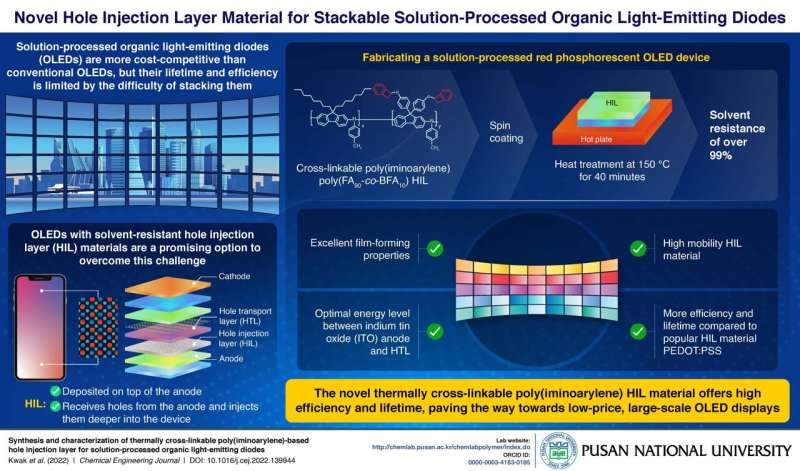
Organic light-emitting diode (OLED) displays are widely used in cameras, mobile phones, television sets, and other modern day electronic devices. However, the present technology for fabricating OLEDs is cost and labor intensive. In this regard, solution-processed OLEDs offer the promise of an economical, large-scale fabrication technique.
However, solution-processed OLEDs have limited efficiency and lifetime owing to the difficulty of stacking the constituent layers such as the anode, cathode, hole injection layer (HIL), hole transport layer (HTL), etc. on top of each other to construct the LED.
“Research is being conducted to solve this problem using solvent-resistant materials. Many HTL materials having solvent resistance have been developed, but research on the HIL has not been conducted much,” explains Professor Do-Hoon Hwang from the Department of Chemistry at Pusan National University, Korea, who has been conducting research on organic semiconductor materials and electronic device applications for over two decades.
To this end, Prof. Hwang and his colleagues have synthesized and characterized a novel solvent-resistant HIL material, thermally cross-linkable poly(iminoarylene) poly(FA90-co-BFA10), and fabricated a functional solution-processed red phosphorescent OLED device using the same.
In a recent article published in Chemical Engineering Journal, the researchers have detailed this breakthrough development.
This novel HIL material with over 99% solvent resistance, has an optimum energy level that is intermediate between that of the indium tin oxide (ITO) electrode and the HTL. As a result, the researchers achieved photo-crosslinking of (poly-TPD) as HTL on top of crosslinked HIL. Moreover, the researchers demonstrated that the HIL material has high mobility and excellent film-forming properties that are crucial for the commercial viability of solution-processed OLEDs.
“Remarkably, the researchers achieved a greater efficiency and lifetime with this novel HIL material, compared to (PEDOT:PSS), the most widely used hole injection layer material, in terms of efficiency and lifetime,” notes Prof. Hwang.
Taken together, this development is a major step forward for the commercialization of efficient solution-processed OLED displays.
More information:
Seon Lee Kwak et al, Synthesis and characterization of thermally cross-linkable poly(iminoarylene)-based hole injection layer for solution-processed organic light-emitting diodes, Chemical Engineering Journal (2022). DOI: 10.1016/j.cej.2022.139944
Provided by
Pusan National University
Citation:
Researchers develop novel stackable hole injection layer material for solution-processed OLEDs (2023, March 15)
retrieved 15 March 2023
from https://techxplore.com/news/2023-03-stackable-hole-layer-material-solution-processed.html
This document is subject to copyright. Apart from any fair dealing for the purpose of private study or research, no
part may be reproduced without the written permission. The content is provided for information purposes only.
For all the latest Technology News Click Here
For the latest news and updates, follow us on Google News.

